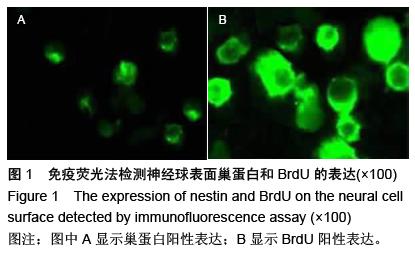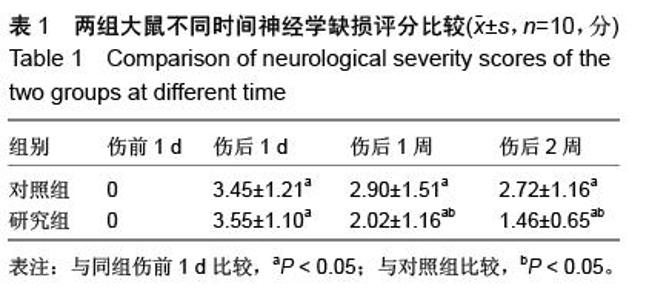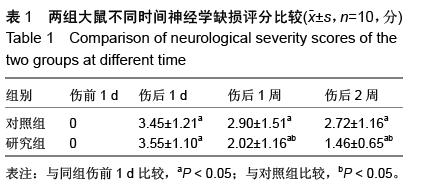| [1] 高伟东,李晓冬.胚胎神经干细胞对脑损伤治疗作用的实验研究[J].解剖学研究,2010,32(1):39-42.[2] 韩志桐,苏宁,吴日乐,等.GFP 转基因小鼠神经干细胞移植治疗大鼠帕金森病的实验研究[J].临床神经外科杂志, 2012,9(3):139-142. [3] 杨忠旭,张颖,历俊华,等.神经干细胞移植治疗颞叶癫痫的近期效果研究[J].中国神经外科疾病研究杂志,2010,9(4): 304-307. [4] 牛光清,郭镔容,常晓燕,等.神经干细胞移植治疗脑梗死后遗症临床分析[J].中国医药,2010,5(7):615-616. [5] 温慧娟.护理路径在重型颅脑外伤患者急救中的应用[J].护理实践与研究,2011,8(16):45-46.[6] 陈涛,田增民,尹丰,等.神经干细胞移植治疗帕金森病的临床研究[J].中国微侵袭神经外科杂志,2012,17(10): 452-453. [7] 邱英,邢智伟,曹冉华,等.神经干细胞治疗难治性癫痫临床研究[J].内蒙古医学院学报,2010,34(5):387-391. [8] 张化明,杨海,马江红,等.神经干细胞移植并手术治疗重型颅脑损伤的疗效分析[J].中国实用神经疾病杂志,2013, 16(13):52-53. [9] 马兴才.手术治疗73 例重症颅脑外伤的临床研究[J].中国中医药咨询,2011,3(16):421-422.[10] 包晓群,宋亚彬,李松涛,等.神经干细胞移植治疗帕金森病[J].中国老年学杂志,2013,33(8):3591-3592. [11] 杨春,周辉,白琳琳,等.神经干细胞移植对阿尔茨海默病大鼠海马突触素表达和学习记忆能力的影响[J].中国组织工程研究与临床康复,2010,14(10):1803-1807.[12] 娄永利.神经干细胞移植治疗脊髓损伤的临床研究[J].中外医疗,2012,31(2):22. [13] 姜颢,张连东,葛燕萍,等.无框架立体定向钻孔引流术治疗高血压性脑出血并发症的临床分析[J].中国急救医学, 2010,30(6):537-539.[14] 吴长山,郭志强.28 例双额叶挫裂伤手术干预及预后分析[J].中外医学研究,2012,10(21):114-115.[15] 常志田,郭丹.神经干细胞脑内移植治疗中枢神经损伤21例临床观察[J].中国医药导刊,2010,12(5):891.[16] 谭德瑜,潘淳,黎浩然.弥漫性轴索损伤52例临床分析[J].广西医科大学学报,2013,30(4):631-632. [17] 黄旅黔,龚明,王忠安,等.立体定向联合显微手术治疗丘脑高血压脑出血临床预后分析[J].中华神经医学杂志,2012, 11(8)815-818.[18] 孔令霞,常永霞,许津莉.肌内注射神经生长因子联合早期干预对缺血缺氧脑病的疗效研究[J].河北医药,2014, 36(2):185-186.[19] 王鹏,邢红伟,周志武.脑外伤致持续性植物状态的催醒治疗研究进展[J].疑难病杂志,2014,13(1):99-101,107.[20] 路丕周,张维涛,张剑宁,等.微侵袭立体定向引导颅内小病灶手术治疗60例[J].陕西医学杂志,2013,42(5): 549-550. [21] Cooper DJ, Rosenfeld JV, Murray L, et al. Decompressive craniectomy in diffuse traumatic brain injury. N Engl J Med. 2011;364(16):1493-1502.[22] Gempt J, Buchmann N, Ryang YM, et al. Frameless image-guided stereotaxy with real-time visual feedback for brain biopsy. Acta Neurochir (Wien). 2012;154(9): 1663-1667.[23] Leibson CL, Brown AW, Hall Long K, et al. Medical care costs associated with traumatic brain injury over the full spectrum of disease: a controlled population-based study.J Neurotrauma. 2012;29(11): 2038-2049. [24] Waldau B, Hattiangady B, Kuruba R, et al. Medial ganglionic eminence-derived neural stem cell grafts ease spontaneous seizures and restore GDNF expression in a rat model of chronic temporal lobe epilepsy. Stem Cells. 2010;28(7):1153-1164.[25] Chen X, Xu BN, Meng X, et al. Dual-room 1.5-T intraoperative magnetic resonance imaging suite with a movable magnet: implementation and preliminary experience. Neurosurg Rev. 2012;35(1):95-109. [26] Lowry N, Goderie SK, Adamo M, et al. Multipotent embryonic spinal cord stem cells expanded by endothelial factors and Shh/RA promote functional recovery after spinal cord injury. Exp Neurol. 2008; 209(2):510-522.[27] Wang F, Zhu Y. The interaction of Nogo-66 receptor with Nogo-p4 inhibits the neuronal differentiation of neural stem cells. Neuroscience. 2008;151(1):74-81.[28] Brenneman MM, Wagner SJ, Cheatwood JL, et al. Nogo-A inhibition induces recovery from neglect in rats. Behav Brain Res. 2008;187(2):262-272.[29] Guo X, Guo Y. Expression of Nogo-A mRNA after injury of the rat central nervous system.Neural Regen Res. 2008;3(12):1368-1371.[30] Wannier-Morino P, Schmidlin E, Freund P, et al. Fate of rubrospinal neurons after unilateral section of the cervical spinal cord in adult macaque monkeys: effects of an antibody treatment neutralizing Nogo-A. Brain Res. 2008;1217:96-109.[31] Yu P, Huang L, Zou J, et al. Immunization with recombinant Nogo-66 receptor (NgR) promotes axonal regeneration and recovery of function after spinal cord injury in rats. Neurobiol Dis. 2008;32(3):535-542.[32] Zhan R, Chen SJ. Effects of Nogo-neutralizing antibody and neurotrophin-3 on axonal regeneration following spinal cord injury in rat.Neural Regen Res. 2008;3(12):1319-1323.[33] Parr AM, Kulbatski I, Wang XH, et al. Fate of transplanted adult neural stem/progenitor cells and bone marrow-derived mesenchymal stromal cells in the injured adult rat spinal cord and impact on functional recovery. Surg Neurol. 2008;70(6):600-607.[34] Jiang W, Xia F, Han J, et al. Patterns of Nogo-A, NgR, and RhoA expression in the brain tissues of rats with focal cerebral infarction.Transl Res. 2009;154(1):40-48.[35] Gu S, Huang H, Bi J, et al. Combined treatment of neurotrophin-3 gene and neural stem cells is ameliorative to behavior recovery of Parkinson's disease rat model. Brain Res. 2009;1257:1-9.[36] Mothe AJ, Tator CH. Transplanted neural stem/progenitor cells generate myelinating oligodendrocytes and Schwann cells in spinal cord demyelination and dysmyelination. Exp Neurol. 2008; 213(1):176-190.[37] Duan X, Kang E, Liu CY, et al. Development of neural stem cell in the adult brain. Curr Opin Neurobiol. 2008; 18(1):108-115. [38] Delcroix GJ, Jacquart M, Lemaire L, et al. Mesenchymal and neural stem cells labeled with HEDP-coated SPIO nanoparticles: in vitro characterization and migration potential in rat brain. Brain Res. 2009;1255:18-31.[39] Tian ZM, Chen T, Zhong N, et al. Clinical study of transplantation of neural stem cells in therapy of inherited cerebellar atrophy. Beijing Da Xue Xue Bao. 2009;41(4):456-458.[40] Chen W, Xu ZM, Wang G, et al. Non-motor symptoms of Parkinson's disease in China: a review of the literature. Parkinsonism Relat Disord. 2012;18(5):446-452. |





